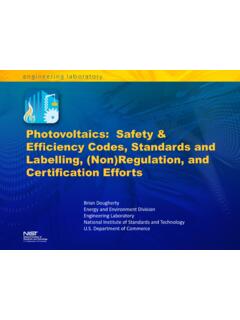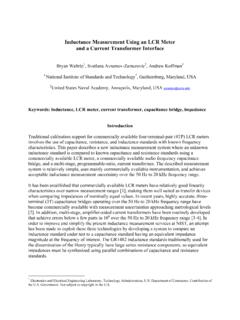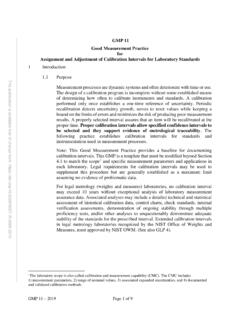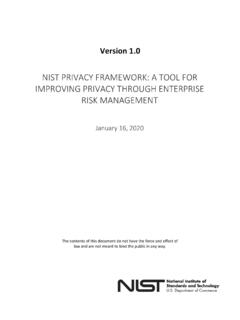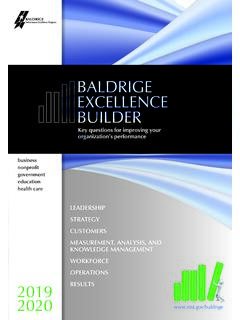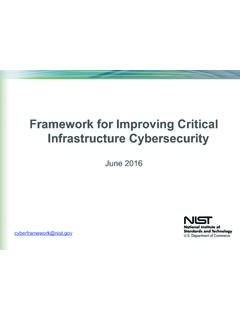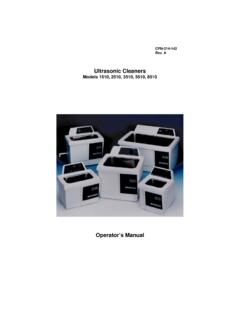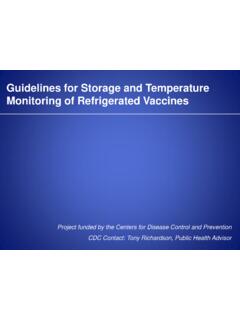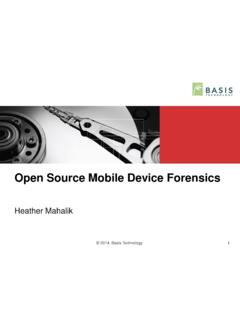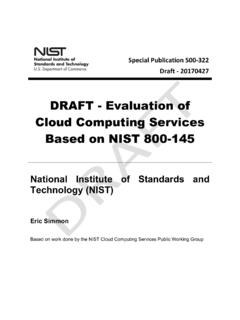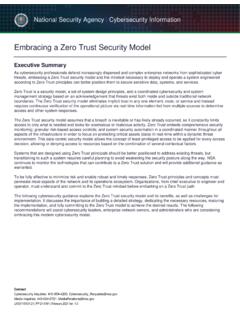Transcription of NIST Risk Management Framework Overview
1 NIST Risk Management Framework OverviewNIST Risk Management Framework Overview About the NIST Risk Management Framework (RMF) Supporting Publications The RMF Steps Step 1: CategorizeStep 2: SelectStep 3: ImplementStep 4: AssessStep 5: AuthorizeStep 6: Monitor Additional Resources and contact Information NIST Risk Management Framework | 2 A holistic and comprehensive risk Management process Integrates the Risk Management Framework (RMF) into the system development lifecycle (SDLC) Provides processes (tasks) for each of the six steps in the RMF at the system levelNIST Special Publication 800-37, Guide for Applying the Risk Management FrameworkCategorize SystemSelect ControlsImplement ControlsAssess ControlsAuthorize SystemMonitor ControlsNIST Risk Management Framework | 3 Supporting Publications Federal Information Processing Standards (FIPS) FIPS 199 Standards for Security Categorization FIPS 200 Minimum Security Requirements Special Publications (SPs)
2 SP 800-18 Guide for System Security Plan Development SP 800-30 Guide for Conducting Risk Assessments SP 800-34 Guide for Contingency Plan development SP 800-37 Guide for Applying the Risk Management Framework SP 800-39 Managing Information Security Risk SP 800-53/53A Security Controls Catalog and Assessment Procedures SP 800-60 Mapping Information Types to Security Categories SP 800-128 Security-focused Configuration Management SP 800-137 Information Security Continuous Monitoring Many others for operational and technical implementationsNIST Risk Management Framework | 4 NIST SP 800-39: Managing Information Security Risk Organization, Mission, and Information System View Multi-level risk Management approach Implemented by the Risk Executive Function Enterprise Architecture and SDLC Focus Supports all steps in the RMFNIST Risk Management Framework | 5 Three Levels of Organization-Wide Risk ManagementStrategic FocusTactical FocusLevel 1 OrganizationLevel 2 Mission / Business ProcessLevel 3 System (Environment of Operation)AssessRespondMonitorNIST Risk Management Framework | 6 NIST SP 800-39.
3 Managing Information Security Risk Organization, Mission, and Information System ViewFrameRisk Management ProcessInformation andCommunication FlowsNIST Special Publication 800-30, Guide to Conducting Risk Assessments Addresses the Assessing Risk component of Risk Management (from SP 800-39) Provides guidance on applying risk assessment concepts to: All three tiers in the risk Management hierarchy Each step in the Risk Management Framework Supports all steps of the RMF A 3-step Process Step 1: Prepare for assessment Step 2: Conduct the assessment Step 3: Maintain the assessment NIST Risk Management Framework | 7 A holistic and comprehensive risk Management process Integrates the Risk Management Framework (RMF) into the system development lifecycle (SDLC) Provides processes (tasks) for each of the six steps in the RMF at the system levelNIST Risk Management Framework | 8 NIST Special Publication 800-37, Guide for Applying the Risk Management FrameworkCategorize SystemSelect ControlsImplement ControlsAssess ControlsAuthorize SystemMonitor ControlsNIST RMF Step 1: Categorize Purpose.
4 Determine the criticalityof the information and systemaccording to potential worst-case, adverse impactto the organization, mission/business functions, and the Risk Management Framework | 9 Federal Information Processing Standard (FIPS) 199 NIST Risk Management Framework | 10 Security ObjectivesConfidentialityAvailabilityInt egrityStandards for Security Categorization of Federal Information and Information SystemsImpact LevelLow: losshas limited adverse impactModerate:loss has serious adverse impactHigh: loss has catastrophic adverse impactNIST RMF Step 2: SelectPurpose: Selectsecurity controls starting with the appropriate baseline using categorization outputfrom Step 1 Apply tailoring guidanceas needed based on risk assessmentNIST Risk Management Framework | 12 Federal Information Processing Standard (FIPS) 200 Defines 17 security-related areas (families) that.
5 Represent a broad-based, balanced security program Include Management , operational , and technical security controls (all are needed for defense in depth) Specifies that a minimum baseline of security controls, as defined in NIST SP 800-53, will be implemented Specifies that the baselines are to be appropriately tailoredNIST Risk Management Framework | 13 Minimum Security Requirements for Federal Information and Information SystemsNIST Special Publication 800-53 A catalog of security controls Defines three security baselines (L, M, H) Initial version published in 2005 Currently using Rev. 4 (2013) Undergoing update to Rev. 5, draft released in Aug 2017 for public comment NIST Risk Management Framework | 14 Security and Privacy Controls for Information Systems and OrganizationsSecurity and Privacy Controls A countermeasure prescribed for system or an organization designed to protect the confidentiality, integrity, and availability of its information and to meet a set of defined requirements.
6 Security and privacy controls are intentionally not focused on any specific technologies Control implementations and assessment methods may vary based on the technology to which the control is being applied, : Cloud-based systems Mobile systems Applications NIST Risk Management Framework | 16SP 800-53 Control FamiliesAC Access ControlMP Media ProtectionAT Awareness and TrainingPA * Privacy AuthorizationAU Audit and Accountability PE Physical and Environmental ProtectionCA Security Assessment and AuthorizationPL PlanningCM Configuration ManagementPM Program ManagementCP Contingency PlanningPS Personnel SecurityIA Identification and AuthenticationRA Risk AssessmentIP* Individual ParticipationSA System and Service AcquisitionIR Incident ResponseSC System and Communication ProtectionMA - MaintenanceSI System and Information IntegrityNIST Risk Management Framework | 17SP 800-53 Control Baselines Baselines are defined in Appendix D Determined by.
7 Information and system categorization (L, M, H) Organizational risk assessment and risk tolerance System level risk assessment Baselines canand shouldbe tailored, based on RISK, to fit the mission and system environment Some controls are not included in baselinesNIST Risk Management Framework | 19 NIST RMF Step 3: ImplementPurpose: Implementsecurity controls within enterprise architecture and systems using sound system security engineering practices (see SP 800-160); apply security configuration Risk Management Framework | 20 Implementation Tips Plan for control implementation during the development phase of the SDLC BAKE IT IN Many NIST publications are available to provide implementation guidance on a wide range of controls and control types ( ) Implementation may include: Writing and following policies, plans, and operational procedures Configuring settings in operating systems and applications Installing tools/software to automate control implementation TrainingNIST Risk Management Framework | 21 NIST RMF Step 4: AssessPurpose: Determine security control effectiveness are controls implemented correctly, operating as intended, and meeting the security requirementsfor the system and environment of operation?
8 NIST Risk Management Framework | 22 NIST Special Publication 800-53A Supports RMF Step 4 (Assess) Is a companion document to 800-53 Is updated shortly after 800-53 is updated Describes high level procedures for assessing security controls for effectiveness Defines assessment procedures using Assessment Objectives Assessment Methods Assessment ObjectsNIST Risk Management Framework | 23 Assessing Security and Privacy Controls in Systems and Organizations: Building Effective Security Assessment PlansSP 800-53A Assessment the Security Assessment which controls are to be appropriate procedures to assess those depth and coverage needed for the assessment procedures the plan and obtain the the the Security Assessment ReportNIST Risk Management Framework | 24SP 800-53A Assessment Procedures Parts Assessment objectives determination statements Three assessment methodsand associated assessment objects Interview objects are individuals/groups of individuals Examine objects include: Specifications ( , documents - policies, procedures, designs) Mechanisms ( , functionality in HW, SW, firmware) Activities ( , system ops, administration, mgmt.)
9 , exercises) Te s t objects include: Mechanisms ( , HW, SW, firmware) Activities ( , system ops, administration, mgmt., exercises)NIST Risk Management Framework | 25 NIST RMF Step 5: AuthorizePurpose: The Authorizing Official (AO) examines the outputof the security controls assessment to determine whether or not the risk is acceptable The AO may consult with the Risk Executive (Function), the Chief Information Officer, the Chief Information Security Officer, as needed since aggregate risk should be considered for the authorization decision After the initial authorization, ongoing authorization is put in place using output from continuous monitoring (see Supplemental Guidance on Ongoing Authorization at: )NIST Risk Management Framework | 27 NIST RMF Step 6: MonitorPurpose: Continuously monitor controls implemented for the system and its environment of operation for changes, signs of attack, etc.
10 That may affect controls, and reassess control effectiveness Incorporate all monitoring(800-39 risk monitoring, 800-128 configuration Management monitoring, 800-137 control effectiveness monitoring, etc.) into an integrated organization-wide monitoring programNIST Risk Management Framework | 31 Examples of ApplicationsNIST Interagency Report 7628, Rev. 1, Guidelines for Smart Grid CybersecurityFISMA Overview | 35 The Federal Risk and Authorization Management Program (FedRAMP) is a government-wide program that provides a standardized approach to security assessment, authorization, and continuous monitoringfor cloudproducts and on national Security SystemsOverlays for specific national security systems/ operational environments, such as: space platform, privacy, classified information, Resources and contact InformationNIST Risk Management Framework | 36 FISMA Publications: @usaNISTgov@NIST cyberTHANK YOU!
